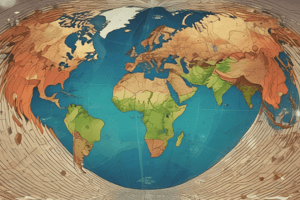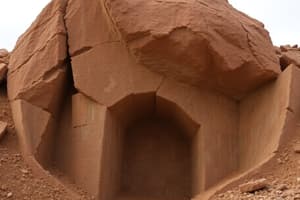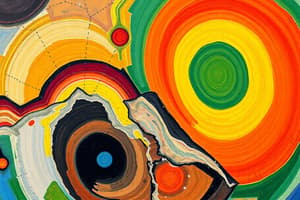Podcast
Questions and Answers
What is the study of earthquakes and seismic waves called?
What is the study of earthquakes and seismic waves called?
Seismology
What does a seismograph record?
What does a seismograph record?
Vibrations in the ground
Name the types of motion that a modern three-component seismograph records.
Name the types of motion that a modern three-component seismograph records.
Vertical and horizontal motion
How do seismographs record motion?
How do seismographs record motion?
A tracing of earthquake motion that is recorded by a seismograph is called a(n)?
A tracing of earthquake motion that is recorded by a seismograph is called a(n)?
Why are P waves the first waves to be recorded by a seismograph?
Why are P waves the first waves to be recorded by a seismograph?
Which type of wave is the second wave to be recorded by a seismograph?
Which type of wave is the second wave to be recorded by a seismograph?
What types of waves are the slowest, and therefore the last to be recorded by a seismograph?
What types of waves are the slowest, and therefore the last to be recorded by a seismograph?
Scientists determine the distance to an epicenter by analyzing?
Scientists determine the distance to an epicenter by analyzing?
The longer the lag time between the arrival of the P waves and the S waves indicates?
The longer the lag time between the arrival of the P waves and the S waves indicates?
Scientists consult a lag-time graph to determine how far an earthquake occurred from?
Scientists consult a lag-time graph to determine how far an earthquake occurred from?
A lag-time graph translates the difference in arrival times of the P waves and S waves into distance from the epicenter to?
A lag-time graph translates the difference in arrival times of the P waves and S waves into distance from the epicenter to?
What does a lag-time graph determine about an earthquake?
What does a lag-time graph determine about an earthquake?
Before computers were widely available, how did scientists locate the epicenter of an earthquake?
Before computers were widely available, how did scientists locate the epicenter of an earthquake?
On the early maps, the radius of each circle was equal to what?
On the early maps, the radius of each circle was equal to what?
Where would the epicenter of the earthquake be found on the map?
Where would the epicenter of the earthquake be found on the map?
Scientists who study earthquakes are interested in the amount of?
Scientists who study earthquakes are interested in the amount of?
Magnitude refers to?
Magnitude refers to?
What is the Richter scale?
What is the Richter scale?
What does the moment magnitude measure?
What does the moment magnitude measure?
Intensity measures?
Intensity measures?
What is the Mercalli scale?
What is the Mercalli scale?
Which magnitude scale was widely used for most of the 20th century?
Which magnitude scale was widely used for most of the 20th century?
Which magnitude scale do scientists generally prefer now?
Which magnitude scale do scientists generally prefer now?
The Richter scale and the moment magnitude scale provide similar values for?
The Richter scale and the moment magnitude scale provide similar values for?
The moment magnitude scale is more accurate for measuring?
The moment magnitude scale is more accurate for measuring?
What was the highest moment magnitude recorded for an earthquake so far?
What was the highest moment magnitude recorded for an earthquake so far?
What was the moment magnitude of the quake in Kobe, Japan, in 1995?
What was the moment magnitude of the quake in Kobe, Japan, in 1995?
What is the moment magnitude of earthquakes that generally are not felt by people?
What is the moment magnitude of earthquakes that generally are not felt by people?
How is intensity I described on the modified Mercalli intensity scale?
How is intensity I described on the modified Mercalli intensity scale?
How is intensity XII described on the modified Mercalli intensity scale?
How is intensity XII described on the modified Mercalli intensity scale?
Flashcards are hidden until you start studying
Study Notes
Seismology Overview
- Seismology is the scientific study of earthquakes and seismic waves.
- Seismographs are instruments used to record ground vibrations.
Seismograph Functionality
- Modern three-component seismographs record vertical and horizontal ground motion:
- One device for vertical motion.
- Two devices for horizontal motion (east-west and north-south).
- Seismographs track motion either on paper via wave-shaped lines or through electromagnetic signals.
Seismograms and Wave Types
- A seismogram is the recorded tracing of earthquake motion.
- P waves (Primary waves) are the fastest seismic waves and the first to be recorded.
- S waves (Secondary waves) follow P waves as the second type recorded.
- Surface waves, which include Rayleigh and Love waves, are the slowest and last to be recorded.
Determining Epicenter Distance
- The distance to an earthquake's epicenter is determined by analyzing the arrival times of P and S waves.
- A longer lag time between P and S waves indicates a greater distance from the seismograph to the epicenter.
- Lag-time graphs illustrate the difference in arrival times to calculate distances from the epicenter to each station.
Locating Earthquake Epicenters
- Historically, finding an epicenter involved drawing circles around at least three seismograph stations on a map.
- The intersection of circles from these stations pinpointed the epicenter's location.
Earthquake Energy and Magnitude
- The energy released by an earthquake is of primary interest to seismologists.
- Magnitude measures the strength of an earthquake.
- The Richter scale measures earthquake strength based on ground motion, widely used in the 20th century.
- The moment magnitude scale measures earthquake strength more accurately, focusing on fault area size, average fault displacement, and rock rigidity.
Intensity and Measurement Scales
- Intensity refers to the level of danger caused by an earthquake.
- The Mercalli scale assesses earthquake intensity in Roman numerals, detailing the effects associated with each level.
Preference for Magnitude Scales
- The Richter scale and moment magnitude scale yield similar values for small earthquakes.
- The moment magnitude scale is preferred, especially for evaluating large earthquakes, providing accuracy.
Record-Breaking Magnitudes
- The highest recorded moment magnitude for an earthquake is 9.5.
- The 1995 Kobe, Japan earthquake had a moment magnitude of 6.9.
- Earthquakes with a moment magnitude of less than 2.5 are generally not felt by people.
Intensity Descriptions
- The modified Mercalli intensity scale classifies intensity from I to XII, describing effects at each level.
- Intensity I indicates minimal effects, while intensity XII signifies total destruction.
Studying That Suits You
Use AI to generate personalized quizzes and flashcards to suit your learning preferences.




